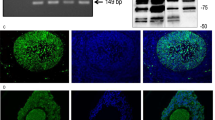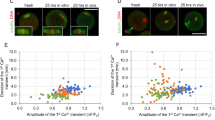Abstract
Thapsigargin (Tg), a selective inhibitor of sarcoplasmic/endoplasmic reticulum Ca2+-ATPase (SERCA), causes depletion of intracellular Ca2+ stores, hence activation of capacitative Ca2+ entry (CCE). Incubation of Xenopus laevis oocytes with Tg resulted in an increased rate of progesterone-induced meiotic maturation. Non-mitochondrial 45Ca2+ uptake by SERCA-containing microsomes prepared from control wild-type oocytes microinjected with sterile water was inhibited essentially 100% by Tg. However, overexpression of Bcl-2, an oncogene known to protect against Tg-induced apoptosis in certain cell types, resulted in only 40% inhibition of microsomal 45Ca2+ uptake by Tg while non-inhibited 45Ca2+ uptake remained unchanged. Moreover Bcl-2 overexpression also protected against inhibition of CCE. ICl(Ca) was similar in Bcl-2-overexpressing and control oocytes when intracellular Ca2+ store depletion was induced by microinjection of inositol 1,4,5-trisphosphate (InsP3) and other means and when CCE was induced by means independent of SERCA inhibition. Our data indicate that Bcl-2 affects neither the InsP3 receptor nor Ca2+ entry itself. At the end of a 24-h period after progesterone addition to the medium, only 25% of Bcl-2-overexpressing oocytes had matured compared to 85% of control oocytes. Our data suggest that SERCA participates in Xenopus oocyte maturation by controlling cytosolic Ca2+ and/or intracellular Ca2+ stores, hence CCE. An observed progesterone-dependent protein kinase-catalysed phosphorylation of SERCA is further indication of its role in oocyte maturation.
This is a preview of subscription content, access via your institution
Access options
Subscribe to this journal
Receive 50 print issues and online access
$259.00 per year
only $5.18 per issue
Buy this article
- Purchase on Springer Link
- Instant access to full article PDF
Prices may be subject to local taxes which are calculated during checkout







Similar content being viewed by others
References
Antipenko AY, Spielman AI and Kirchberger MA. . 1997 J. Biol. Chem. 272: 2852–2860.
Antipenko AY and Kirchberger MA. . 1997 Cardiovasc. Res. 36: 67–77.
Baffy G, Miyashita T, Williamson JR and Reed JC. . 1993 J. Biol. Chem. 268: 6511–6519.
Bian X, Hughes FM Jr, Huang Y, Cidlowski JA and Putney Jr. JW. . 1997 Am. J. Physiol. 272: (4 Pt 1) C1241–C1249.
Boyer J, Belle R, Capony J.-P and Ozon R. . 1983 Biochimie 65: 15–23.
Choi OH, Lee JH, Kessessinoff T, Cunha-Melo JR, Jones SVP and Beaven MA. . 1993 J. Immunol. 151: 5586–5595.
Distelhorst CW, Lam M and McCormick TS. . 1996 Oncogene 12: 2051–2055.
Durieux ME, Salafranca MN, Lynch KR and Moorman JR. . 1992 Amer. J. Physiol. 263: C896–C900.
Enouf J, Bredoux R, Bourdeau N and Levy-Toledano S. . 1987 J. Biol. Chem. 262: 92993–92997.
Foyouzi-Youssefi R, Arnaudeau S, Borner C, Kelley W, Tschopp J, Lew DP, Demaraurex N and Krause K-H. . 2000 Proc. Natl. Acad. Sci. USA 97: 5723–5728.
Furukawa Y, Iwase S, Kikuchi J, Terui Y, Nakamura M, Yamada H, Kano Y and Matsuda M. . 2000 J. Biol. Chem. 275: 21661–21667.
Hacki J, Egger L, Monney L, Conus S, Rosse T, Fellay I and Borner C. . 2000 Oncogene 19: 2286–2295.
Han J-K and Lee S-K. . 1995 Biochem. Biophys. Res. Commun. 217: 931–939.
He H, Lam M, McCormick TS and Distelhorst CW. . 1997 J. Cell. Biol. 138: 1219–1228.
Hunter JJ, Bond BL and Parslow TG. . 1996 Mol. Cell. Biol. 16: 877–873.
Kijima Y, Ogunbunmi E and Fleischer S. . 1991 J. Biol. Chem. 266: 22912–22918.
Kobrinsky E, Ondrias K and Marks AR. . 1995 Dev. Biol. 172: 531–540.
Kobrinsky E, Spielman AI, Rosenzweig S and Marks AR. . 1999 Am. J. Physiol. 277: (4 Pt 1) C665–C672.
Kroemer G. . 1999 Biochem. Soc. Symp. 66: 1–15.
Kuo TH, Kim H-RC, Zhu L, Yu Y, Lin H-M and Tsang W. . 1998 Oncogene 17: 1903–1910.
Lam M, Dubyak G, Chen L, Nunez G, Miesfeld RL and Distelhorst CW. . 1994 Proc. Natl. Acad. Sci. USA 91: 6569–6573.
Lechleiter JD, John LM and Camacho P. . 1998 Biophys. Chem. 72: 123–129.
Mahaney J, Barlow A, Honaker B, Huffman J and Muchnok T. . 1999 Arch. Biochem. Biophys. 372: 408–413.
Matten WT and Vande Woude GF. . 1994 Sem. Dev. Biol. 5: 173–181.
Mattiazzi A, Hove-Madsen L and Bers DM. . 1994 Am. J. Physiol. 267: (Heart Circ. Physiol. 36) H812–H820.
Nakamura K, Bossy-Wetzel E, Burns K, Fadel MP, Lozyk M, Goping IS, Opas M, Bleackley RC, Green DR and Michalak M. . 2000 J. Cell Biol. 150: 731–740.
Newton K and Strasser A. . 1998 Curr. Opin. Genet. Dev. 8: 68–75.
Parys JB, Sernett SW, DeLisle S, Snyder PM, Welsh MJ and Campbell KP. . 1992 J. Biol. Chem. 267: 18776–18782.
Petersen CC and Berridge MJ. . 1994 J. Biol. Chem. 269: 32246–32253.
Peterson GL. . 1977 Anal. Biochem. 83: 346–356.
Picard A, Cavadore JC, Lory P, Bernengo JC, Ojeda C and Doree M. . 1990 Science 247: 327–329.
Pinton P, Ferrari D, Magalhaes P, Schulze-Osthoff K, Di Virgilio F, Pozzan T and Rizutto R.J. . 2000 J. Cell. Biol. 148: 857–862.
Sagara Y, Wade JB and Inesi G. . 1992 J. Biol. Chem. 267: 1286–1292.
Shibasaki F, Kondo E, Akagi T and McKeon F. . 1997 Nature 386: 728–731.
Simmerman HK and Jones LR. . 1998 Physiol. Rev. 78: 921–947.
Stehno-Bittel L, Krapivinsky G, Krapivinsky L, Perez-Terzic C and Clapham DE. . 1995 J. Biol. Chem. 270: 30068–30074.
Thastrup O, Cullen PJ, Drobak BK, Hanley MR and Dawson AP. . 1990 Proc. Natl. Acad. Sci. USA 87: 2466–2470.
Vairo G, Innes KM and Adams JM. . 1996 Oncogene 13: 1511–1519.
Vilain JP, Moumene M and Moreau M. . 1989 J. Exp. Zool. 250: 100–108.
Waldron RT, Short AD and Gill DL. . 1995 J. Biol. Chem. 270: 11955–11961.
Wei H, Wei W, Bredesen DE and Perry DC. . 1998 J. Neurochem. 70: 2305–2314.
Xu A and Narayanan N. . 2000 J. Biol. Chem. 275: 4407–4416.
Zhong L and Inesi G. . 1998 J. Biol. Chem. 273: 12994–12998.
Zhu WH and Loh TT. . 1995 Life Sci. 57: 2091–2099.
Acknowledgements
We thank Dr P Camacho for SERCA2a and 2b cDNA, Dr R Iyengar for M1 muscarinic receptor cRNA, Dr R Kitsis for human Bcl-2 cDNA, and Dr T Parslow for mutant Bcl-2 cDNA. We are grateful to Drs D Logothetis, AR Marks and WB Thornhill for helpful discussions and continued support. We also thank Dr A Antipenko for input in early stages of the work. This work was supported by grant HL15764 from the National Institutes of Health.
Author information
Authors and Affiliations
Rights and permissions
About this article
Cite this article
Kobrinsky, E., Kirchberger, M. Evidence for a role of the sarcoplasmic/endoplasmic reticulum Ca2+-ATPase in thapsigargin and Bcl-2 induced changes in Xenopus laevis oocyte maturation. Oncogene 20, 933–941 (2001). https://doi.org/10.1038/sj.onc.1204153
Received:
Revised:
Accepted:
Published:
Issue Date:
DOI: https://doi.org/10.1038/sj.onc.1204153
Keywords
This article is cited by
-
Bcl-2 proteins and calcium signaling: complexity beneath the surface
Oncogene (2016)
-
The selective BH4-domain biology of Bcl-2-family members: IP3Rs and beyond
Cellular and Molecular Life Sciences (2013)



